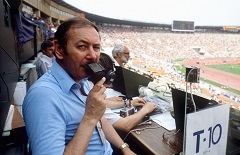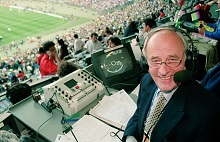Sport, money and television
“There’s nowt so queer as folk …” is (and I’ve just looked this up) an old idiom from either Yorkshire or Lancashire and probably comes from the same stable as “There’s always someone worse off than yerself …”.
Be that as it may, I was reminded of it overnight as I saw a report in the media about the recent respective audience ratings for the cricket World Cup and Wimbledon.
See here for a link to the piece on the website of – THE INDEPENDENT
 Back in the day – my day – there was an accepted terrestrial television protocol in the UK between the BBC and ITV whereby the FA Cup, Wimbledon, the Derby, the Grand National, the Olympics and other great world sporting tournaments [collectively known as the sporting “Crown Jewels”] were always to be made available free-to-air by either the BBC and/or ITV as part of a ‘service to the population’ national broadcaster duty.
Back in the day – my day – there was an accepted terrestrial television protocol in the UK between the BBC and ITV whereby the FA Cup, Wimbledon, the Derby, the Grand National, the Olympics and other great world sporting tournaments [collectively known as the sporting “Crown Jewels”] were always to be made available free-to-air by either the BBC and/or ITV as part of a ‘service to the population’ national broadcaster duty.
In those days it used to work one of two ways. Either one of the two broadcasters effectively ‘owned’ a Crown Jewel and the other would never attempt to wrestle it away (via use of the chequebook or any other means) … or sometimes they opted instead to both cover it.
A famous case in point was the FA Cup.
 Year after year those of us with a certain mindset could if we wished spend most of an FA Cup day switching back and forth between BBC1 and ITV as the sports departments of each tried to knock seven bells out of each other in terms of production, editorial content, quality of anchors, reporters, commentators and pundits.
Year after year those of us with a certain mindset could if we wished spend most of an FA Cup day switching back and forth between BBC1 and ITV as the sports departments of each tried to knock seven bells out of each other in terms of production, editorial content, quality of anchors, reporters, commentators and pundits.
Things would begin with early morning reports from the respective hotels the teams were staying at – probably with reports of which outfielders had opted for Cornflakes rather than Oat Crunchies for breakfast – and continued unabated with coverage of what coloured suits and ties the teams would be wearing on the coach to Wembley Stadium, the coach journey itself via a crew and presenter travelling on board … right through to the previews, the national anthem, the game, the result, the collecting of the FA Cup and the celebrations thereafter.
 All this was accompanied by an unassailable truth that everyone working in British television learned at the knee of the first producer they ever worked for.
All this was accompanied by an unassailable truth that everyone working in British television learned at the knee of the first producer they ever worked for.
It was that, when it came to important national events (whether sporting, Royal or indeed other right up to and including declarations of war) the UK public always turned to “Auntie” (the BBC).
As regards the FA Cup, or example, it didn’t matter a jot whether ITV’s coverage was superior to the BBC’s or not – and, if it was better, certainly not by how much: the inevitable fact was that about 70% of the television audience would always watch the BBC.
And, of course, everyone watched anything of national importance on the BBC.
Which brings me to the relationship with the advent of commercial television funded by subscription – step forward Sky TV, later its BT opponent and now presumably Amazon, Netflix, Facebook and perhaps also one day Google – whose business models spray riches beyond the wildest dreams of King Croesus at the various sporting authorities and their camp followers who run the UK’s sporting “Crown Jewels” in return for the exclusive broadcast rights … this of course at the expense of taking said rights back behind a pay wall costing every prospective individual viewer over time far more their UK Television licence fee if they should ever wish to watch any of them.
For we punters it feels like an outrageous unfairness.
But, to adapt Robin Day’s once famous ‘insult’ to Tory Defence Minister John Nott that caused the latter to discard his microphone and walk out of an interview, to the administrators who are fleetingly – as it were “here today, gone tomorrow” – in notional charge of the well-being of their sport, the thought of all that lovely lolly sloshing into the collective bank account is just to good to pass up.
And later, of course, occasionally the inevitable consequences thereof come embarrassingly home to roost.
Which is why – when England’s cricketers eventually made it through to the Final of the World Cup – Sky TV (‘magnanimously’) did a joint-deal with Channel Four to show the game at Lords ‘live’ and free-to-air.
It was, of course, a sensible decision and one that, on the face of it, worked all-round. The Final attracted a peak audience of over 8 million.
 On the other hand, as my ‘text for today’ also records, simultaneously with the cricket World Cup reaching its climax, a certain epic, not to say classic, five-set Men’s Final was also being played out at Wimbledon, watched at its peak by 9.6 million UK people (including myself) courtesy of the BBC.
On the other hand, as my ‘text for today’ also records, simultaneously with the cricket World Cup reaching its climax, a certain epic, not to say classic, five-set Men’s Final was also being played out at Wimbledon, watched at its peak by 9.6 million UK people (including myself) courtesy of the BBC.
What is better for any sport – to get a thousand tanker loads’ of cash in the hand (sorry, bank) the better to spend upon future development perhaps, at the cost of only being seen on television by a million or few … or to benefit from the boost of being witnessed by a vast television audience and maybe that way attract greater youngster interest?
All I’m saying is that ‘back in my day’ – especially when both the BBC and ITV were broadcasting saturation live coverage – the FA Cup sometimes attracted a combined audience of between 20 and 24 million.
Some of our modern ‘woke’ Millennial social media addicts might benefit from putting that fact in their pipes and smoking it.


